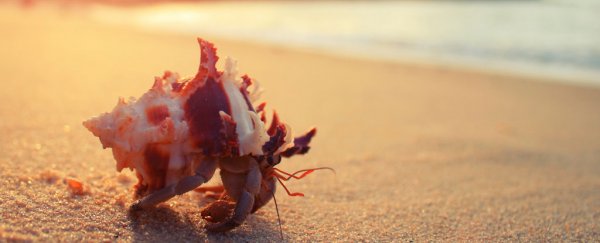In today's anthropogenic world, an innocent hermit crab, just minding its own business and swimming in its search for food, has far more than the usual dangers of predators to contend with.
After expending effort and energy to get to that delicious scent of decaying prawn or mussels, these scavengers may sometimes end up with nutrition-less plastics instead of a fulfilling dinner.
New studies from University of Hull researchers have revealed that several chemicals leaching from plastic pollution poison mussels and befuddling hermit crabs in laboratory experiments.
"Oleamide has a striking resemblance to oleic acid, a chemical released by arthropods during decomposition. As scavengers, hermit crabs may misidentify oleamide as a food source, creating a trap," explained chemical ecologist Paula Schirrmacher.
"Our study shows that oleamide attracts hermit crabs. Respiration rate increases significantly in response to low concentrations of oleamide."
Oleamide is a common plastic additive used as a slip agent, a lubricant for plastics that need to be released from molds after shaping. It also helps the internal structure of plastics, like polypropylene, flow smoothly and is used in a wide number of food containers.
But it is an organic molecule also found naturally in human blood plasma and animal pheromones. In the cleaner shrimp (Lysmata boggessi), oleamide has been found to help catalyze a mating response in sexual partners through a pheromone bouquet.
Contrary to some media reports, oleamide seems only to be involved in triggering food attraction in hermit crabs, not sex.
"Hermit crabs show a behavioral attraction comparable to their response to a feeding stimulant," said Schirrmacher.
"Plastic additives mimicking marine infochemicals may be a problem not limited to hermit crabs and not limited to the odor associated with food," the team wrote in their paper.
Meanwhile, mussels have their own plastic-related difficulties.
DEHP (Di-2-ethylhexyl phthalate), a common plastic softener additive in PVC, was found to interfere with blue mussel (Mytilus species) reproduction systems.
This chemical contributes to almost 40 percent of the global plasticizer market, despite its known biological toxicity.
What's more, the animals are reacting differently to these toxins, along with chemical changes caused by climate change-induced temperature increases, depending on their sex.
While DEHP messed with female mussels' ability to express the genes for their estrogen-related receptors, in males, these genes seem to be expressed more highly under higher water temperatures, which increased their out-of-season spawning organs.
"The combined stressors DEHP and increased temperature, in environmentally relevant magnitudes, have different consequences in male and female mussels, with the potential to impact the timing and breeding season success in Mytilus spp," the researchers wrote in their paper.
"It is critically important to understand how plastic additives work on molecular levels, especially on reproductive success," said ecologist Luana Fiorella Mincarelli.
While these studies involved experimental exposure of the animals to the chemicals in question, they were conducted within the laboratory. They may not fully take into account all the factors that would be involved in their natural environments.
However, that these few chemicals are capable of having such profound impacts on the physiology of the few species studied so far is very concerning.
It's even more concerning given the amount of other chemicals we've also dumped into our world's waters via plastic pollution.
Unless we massively curb our plastic addiction soon, the World Wildlife Foundation warns that there will be more plastic in the ocean than fish by 2050.
Just 20 companies are responsible for over half of the world's single-use plastic, and no doubt have played a huge political and social role in fostering our addiction to their products.
Now, this addiction may be contributing to starving and sexually frustrating countless ocean creatures – including our own food sources.
The research on hermit crabs and mussels was published in the Marine Pollution Bulletin.
